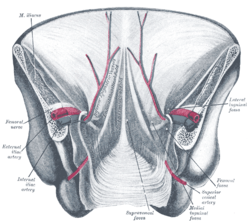In human anatomy, the median umbilical ligament is an unpaired midline ligamentous structure upon the lower inner surface of the anterior abdominal wall.[1] It is covered by the median umbilical fold.[citation needed]
| Median umbilical ligament | |
|---|---|
 Posterior view of the anterior abdominal wall in its lower half. The peritoneum is in place, and the various cords are shining through. Median umbilical ligament is not labeled, but it is located just underneath the median umbilical fold, seen in the center of the diagram | |
| Details | |
| From | Apex of urinary bladder |
| To | Umbilicus |
| Identifiers | |
| Latin | ligamentum umbilicale medianum, ligamentum suspensorium vesicae urinariae |
| TA98 | A08.3.01.007 |
| TA2 | 4322 |
| FMA | 16568 |
| Anatomical terminology | |
The median umbilical ligament represents the remnant of the fetal urachus.[1][2] It extends from the apex of the bladder to the umbilicus, on the deep surface of the anterior abdominal wall.[2]
The median umbilical ligament represents one of the five ligaments of the internal anterior abdominal wall inferior to the umbilicus; laterally on either side of it are one medial umbilical ligament and finally one lateral umbilical ligament.[1]
Development
editThe median umbilical ligament begins as the allantois in the embryonic period. It then becomes the urachus in the fetus.[3][4] This later develops into the median umbilical ligament at birth.[3] It is also formed from the cloaca in utero.[2]
Function
editThe median umbilical ligament has no known function.[2]
Clinical significance
editThe median umbilical ligament may be used as a landmark for surgeons who are performing laparoscopy, such as laparoscopic inguinal hernia repair. Other than this, it has no function in a born human and may be cut or removed with impunity.
It contains the urachus, which is the obliterated form of the allantois. The allantois forms a communication between the cloaca (terminal part of hindgut) and the amniotic sac during embryonic development. If the urachus fails to close during fetal life, it can result in anatomical abnormalities such as a urachal cyst, urachal fistula, urachal diverticulum or urachal sinus.
In very rare cases the urachus can fail to close fully. This can lead to a condition known as a patent urachus (also urachal fistula). Although it is mainly immediately diagnosed after birth it can occur at any stages of life. In this condition there is a functional tubular connection between the umbilicus and the bladder which can lead to urine draining through the umbilicus. Patients often present with umbilical wetness or recurring infections in the area. Treatment options include laparoscopic surgery, excision of the umbilicus or conservative therapy. Due to limited risks conservative therapy, while still being chosen rarely, has been gaining some traction in the last years.[5]
Society and culture
editThe median umbilical ligament was jokingly referred to as "Xander's ligament" in a YouTube video published by Dr. Alexander R. Toftness (aka. ARTexplains on YouTube), and this name was subsequently used on Wikipedia for a short time.[6] This term was later used in a paper published in Mayo Clinic Proceedings.[6][7][8] The term has also appeared in a medical textbook of obstetrics and gynaecology.[9]
References
edit- ^ a b c Flynn, William; Vickerton, Paula (2022), "Anatomy, Abdomen and Pelvis, Abdominal Wall", StatPearls, Treasure Island (FL): StatPearls Publishing, PMID 31869113, retrieved 2022-12-17
- ^ a b c d Wilson, Anthony L.; Gandhi, Jason; Seyam, Omar; Rahmani, Benjamin; Patel, Shrey; Joshi, Gunjan; Smith, Noel L.; Khan, Sardar Ali (2019-09-01). "Urachal anomalies: A review of pathological conditions, diagnosis, and management". Translational Research in Anatomy. 16: 100041. doi:10.1016/j.tria.2019.100041. ISSN 2214-854X.
- ^ a b Tan C, Simon MA, Dolin N, Gesner L (August 2020). "Incidental vesicourachal diverticulum in a young female". Radiology Case Reports. 15 (8): 1305–1308. doi:10.1016/j.radcr.2020.05.046. PMC 7322240. PMID 32612730.
- ^ Mrad Daly K, Ben Rhouma S, Zaghbib S, Oueslati A, Gharbi M, Nouira Y (September 2019). "Infected urachal cyst in an adult: A case report". Urology Case Reports. 26: 100976. doi:10.1016/j.eucr.2019.100976. PMC 6661533. PMID 31380223.
- ^ Briggs, Kayla B.; Rentea, Rebecca M. (2023), "Patent Urachus", StatPearls, Treasure Island (FL): StatPearls Publishing, PMID 32491655, retrieved 2023-09-22
- ^ a b Wilson C. "This YouTuber Made Up A Name For A Body Part. It Ended Up In A Peer-Reviewed Medical Journal". BuzzFeed. Retrieved 2021-01-23.
- ^ Giridhar KV, Kohli M (October 2017). "Management of Muscle-Invasive Urothelial Cancer and the Emerging Role of Immunotherapy in Advanced Urothelial Cancer". Mayo Clinic Proceedings. 92 (10): 1564–1582. doi:10.1016/j.mayocp.2017.07.010. PMID 28982487.
- ^ Ledger T, Toftness A (August 2020). "The Xander ligament? Caution advised when using online encyclopaedias". Journal of Anatomy. 237 (2): 391. doi:10.1111/joa.13195. PMC 7369185. PMID 32255503.
- ^ DeRuiter MC, Kleinrensink GJ, de Bakker BS (2019). "Chapter 4: Anatomy of the pelvis, pelvic organs and reproductive system". In Steegers E, Fauser B, Hilders C, Jaddoe V, van der Post J, Schoenmakers S (eds.). Textbook of Obstetrics and Gynaecology: A Life Course Approach. bohn stafleu van loghum. pp. 51–84. doi:10.1007/978-90-368-2131-5. ISBN 978-90-368-2130-8. S2CID 59223366.
External links
edit- Median umbilical ligament
- Anatomy figure: 36:01-01 at Human Anatomy Online, SUNY Downstate Medical Center - "The inguinal canal and derivation of the layers of the spermatic cord."
- Anatomy photo:44:04-0105 at the SUNY Downstate Medical Center - "The Male Pelvis: The Urinary Bladder"
- Anatomy image:7576 at the SUNY Downstate Medical Center
- Median umbilical fold
- Anatomy figure: 36:03-12 at Human Anatomy Online, SUNY Downstate Medical Center - "Internal surface of the anterior abdominal wall."